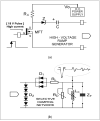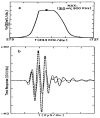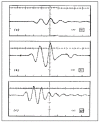Modeling Pulsed High-Power Spikes in Tunable HV Capacitive Drivers of Piezoelectric Wideband Transducers to Improve Dynamic Range and SNR for Ultrasonic Imaging and NDE
- PMID: 34770484
- PMCID: PMC8588323
- DOI: 10.3390/s21217178
Modeling Pulsed High-Power Spikes in Tunable HV Capacitive Drivers of Piezoelectric Wideband Transducers to Improve Dynamic Range and SNR for Ultrasonic Imaging and NDE
Abstract
The signal-to-noise ratios (SNR) of ultrasonic imaging and non-destructive evaluation (NDE) applications can be greatly improved by driving each piezoelectric transducer (single or in array) with tuned HV capacitive-discharge drivers. These can deliver spikes with kW pulsed power at PRF ≈ 5000 spikes/s, achieving levels higher even than in CW high-power ultrasound: up to 5 kWpp. These conclusions are reached here by applying a new strategy proposed for the accurate modeling of own-design re-configurable HV capacitive drivers. To obtain such rigorous spike modeling, the real effects of very high levels of pulsed intensities (3-10 A) and voltages (300-700 V) were computed. Unexpected phenomena were found: intense brief pulses of driving power and probe emitted force, as well as nonlinearities in semiconductors, though their catalog data include only linear ranges. Fortunately, our piezoelectric and circuital devices working in such an intense regime have not shown serious heating problems, since the finally consumed "average" power is rather small. Intensity, power, and voltage, driving wideband transducers from our capacitive drivers, are researched here in order to drastically improve (∆ >> 40 dB) their ultrasonic "net dynamic range available" (NDRA), achieving emitted forces > 240 Newtonspp and receiving ultrasonic signals of up to 76-205 Vpp. These measurements of ultrasonic pulsed voltages, received in NDE and Imaging, are approximately 10,000 larger than those usual today. Thus, NDRA ranges were optimized for three laboratory capacitive drivers (with six commercial transducers), which were successfully applied in the aircraft industry for imaging landing flaps in Boeing wings, despite suffering acoustic losses > 120 dB.
Keywords: HV capacitive-discharge drivers; NDRA; efficient ultrasonic transceivers; high-current driving; industrial NDE; medical imaging; net dynamic range; pulsed high-power spikes; wideband piezoelectric transducers.
Conflict of interest statement
The authors declare no conflict of interest.
Figures















References
-
- Thurston R.N. Effect of electrical and mechanical terminating resistances on loss and bandwidth according to the conventional equiva-lent circuit of a piezoelectric transducer. IRE Trans. Ultrason. Eng. 1960;UE-7:16–25. doi: 10.1109/T-PGUE.1960.29256. - DOI
-
- Kossoff G. The Effects of Backing and Matching on the Performance of Piezoelectric Ceramic Transducers. IEEE Trans. Sonics Ultrason. 1966;13:20–30. doi: 10.1109/T-SU.1966.29370. - DOI
-
- Filipczynski L. Transient equivalent circuit and negative capacitance of a piezoelectric transducer performing thickness vibrations. J. Tech. Phys. 1975;16:121–135.
-
- Hayward G. The influence of pulser parameters on the transmission response of piezoelectric transducers. Ultrasonics. 1985;23:103–112. doi: 10.1016/0041-624X(85)90058-7. - DOI
-
- Ramos A., Sanz P.T., Montero F.R. Broad-band driving of echographic arrays using 10 ns-500 V efficient pulse generators. Ultrasonics. 1987;25:221–228. doi: 10.1016/0041-624X(87)90037-0. - DOI
MeSH terms
LinkOut - more resources
Full Text Sources
Miscellaneous

